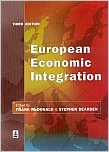| |||||
• polskie
• Zamów informacje o nowościach z wybranego tematu • kontakt |
EUROPEAN ECONOMIC INTEGRATIONMCDONALD F., DEAREDNER S.wydawnictwo: LONGMAN, 1999, wydanie IIIcena netto: European Economic Integration Many changes have taken place in Europe since publication of the last edition of European Economic Integration: the European Union has extended its membership to fifteen countries; European Monetary Union will begin in 1999 with eleven of the member states in the first wave; the Amsterdam Treaty (1997) has extended the scope of the work of the European Union; and, in global terms, the European Union has played an increasing role in influencing developments in political matters as well as trade issues. The Third Edition has been very substantially revised and updated in order to provide up-to-date coverage of the most important issues facing European economies as the European Union moves forward to a single currency and contemplates further enlargement to the east. Key features:
New to Third Edition
The clear and accessible style and its combination of theory and applications have made European Economic Integration one of the most popular texts on courses throughout Europe. Assuming only an introductory knowledge of economics and with its comprehensive coverage of EU economic policies, European Economic Integration is ideally suited for all students taking courses on the economics of the EU as part of an Economics, Business Studies or inter-disciplinary European Studies degree. 438 pages Księgarnia nie działa. Nie odpowiadamy na pytania i nie realizujemy zamówien. Do odwolania !. |


